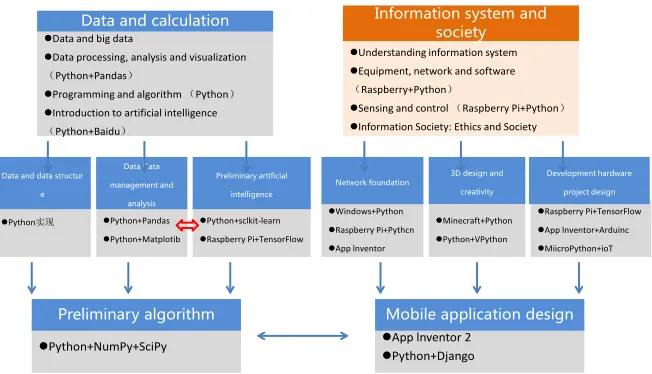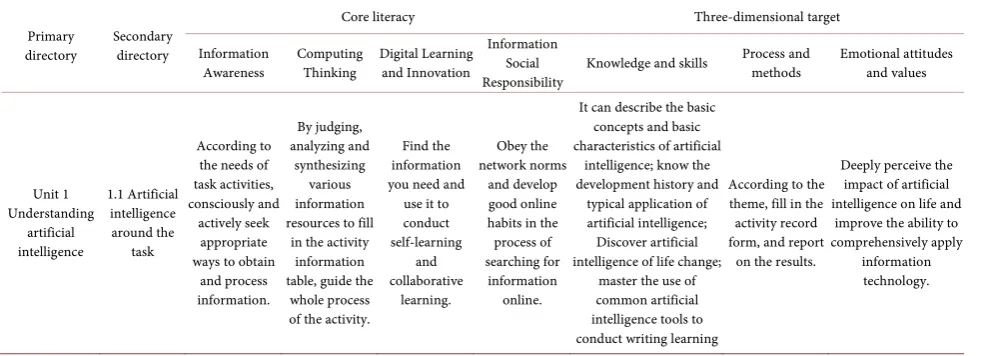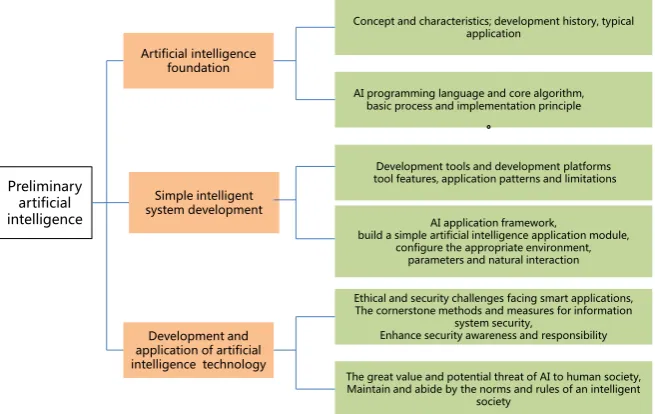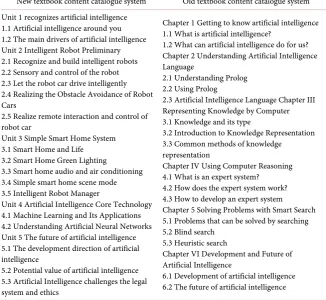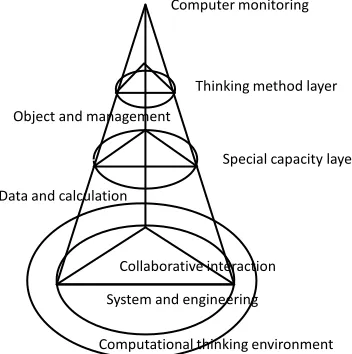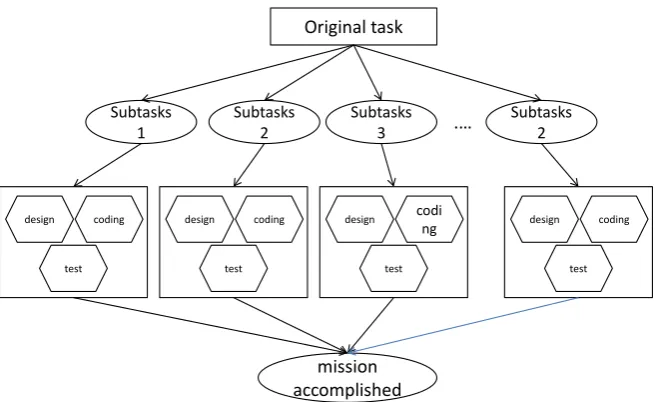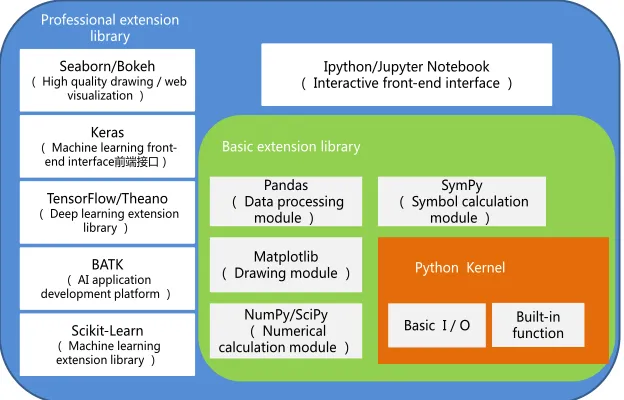ISSN Online: 2333-9721 ISSN Print: 2333-9705
DOI: 10.4236/oalib.1104898 Sep. 30, 2018 1 Open Access Library Journal
Design and Development of High School
Artificial Intelligence Textbook Based on
Computational Thinking
Yanfang Yu, Yuan Chen
Hangzhou Zhejiang Radio and Television University, Hangzhou, China
Abstract
Big data and deep learning technology have once again set off a boom in ar-tificial intelligence. Arar-tificial intelligence has been a major development strategy in many countries. The Chinese government has also written this in-to the “13th Five-Year Plan”, and the Ministry of Education has also launched with the reform measures for artificial intelligence education, the deep inte-gration of “artificial intelligence + education” has been opened. In this con-text, China’s artificial intelligence disciplines and professional construction have set off a major reform storm from colleges to basic education. The revi-sion of this high school artificial intelligence textbook was carried out in this context. The biggest feature of this high school artificial intelligence textbook revision is the integration of computational thinking into the core literacy de-sign. Computational thinking is an indispensable ability of learners in the 21st century. As a typical “digital aboriginal”, high school students must have computational thinking in order to cope with the challenges brought about by the rapid changes in social technology in the future. At present, all developed countries have incorporated computational thinking into national curriculum standards. China has also written computational thinking into national cur-riculum standards and listed it as one of the core literacies of information technology disciplines.
Subject Areas
Artificial Intelligence, Education
Keywords
Artificial Intelligence, Computational Thinking, Core Literacy, Textbook Design
How to cite this paper: Yu, Y.F. and Chen, Y. (2018) Design and Development of High School Artificial Intelligence Textbook Based on Computational Thinking. Open Access Library Journal, 5: e4898.
https://doi.org/10.4236/oalib.1104898
Received: September 10, 2018 Accepted: September 27, 2018 Published: September 30, 2018
Copyright © 2018 by authors and Open Access Library Inc.
This work is licensed under the Creative Commons Attribution International License (CC BY 4.0).
http://creativecommons.org/licenses/by/4.0/
DOI: 10.4236/oalib.1104898 2 Open Access Library Journal
1. Introduction
In July 2017, the “New Generation Artificial Intelligence Development Plan” is-sued by the State Council clearly defined the strategic goal of “three-step” of China’s new generation of artificial intelligence, and proposed six key tasks of each participant, and also issued resources: Configure the program and develop safeguards to ensure implementation of the development plan. And it proposed: the implementation of the national intelligence education project, the establish-ment of artificial intelligence related courses in the primary and secondary schools, and gradually promoting programming education, encouraging social forces to participate in educational programming software, game development and promotion. Artificial intelligence education has been mentioned as a key development location. This indicates that artificial intelligence has risen to the national strategic level, and the deep integration of “artificial intelligence + edu-cation” has been opened. In this context, the Ministry of Education has carried out reform measures for artificial intelligence education. As early as 2014, the Ministry of Education fully implemented the revision of the general high school curriculum and curriculum standards (experiments), and required the core lite-racy of the discipline to be reflected in the revised principles and revised results. In the revision process of this high school information technology textbook, the changes in artificial intelligence textbooks are particularly large, mainly due to the development of the field in the past two years, and the resulting changes in a series of national policy guidelines. The revision of this artificial intelligence textbook is to integrate computational thinking as the main subject thinking into the core literacy design.
Computational thinking reflects the intrinsic value of artificial intelligence curriculum and has become an important part of artificial intelligence teaching research. In March 2006, Prof. Zhou Yizhen from the Department of Computer Science at Carnegie Mellon University in the United States proposed that com-putational thinking is a series of thinking activities that cover the breadth of computer science, such as problem solving, system design, and human behavior
understanding, using the basic concepts of computer science [1]. Zhang Xuejun
believes that computational thinking can enable students to understand the in-formation world in a multi-disciplinary perspective using the disciplinary thinking of information technology, to solve the outstanding problems of the enthusiasm of students in the current development of information technology curriculum, and to further promote the information technology curriculum,
reform and restructuring [2]. Chen Kaiquan regards computational thinking as a
learner’s ability to solve problems, aiming at intelligent society to cultivate the
transformation of students’ information literacy [3]. The “High School
revi-DOI: 10.4236/oalib.1104898 3 Open Access Library Journal
sion of artificial intelligence teaching materials.
Second is the orientation of artificial intelligence in the high school informa-tion technology discipline and its logical relainforma-tionship between disciplines.
At present, many colleges and universities in China have been actively imple-menting the first-level discipline of artificial intelligence. However, in the basic education stage, there is still a lack of curriculum links for corresponding con-tent. Over the years, artificial intelligence has not received much attention in ba-sic education. From textbooks to teachers to related software and hardware facil-ities, development has been slow. This revision of the Ministry of Education textbooks takes the implementation of the fundamental tasks of Lideshu people as a guide, and in-depth summarizes the valuable experience of China’s ordinary high school curriculum reform since the 21st century, fully draws on the out-standing achievements of international curriculum reform, and strives to put the curriculum and curriculum standards of ordinary high schools in China. It is re-vised into a programmatic teaching document that has both international ad-vanced level and actual conditions in China, and builds a general high school curriculum system with Chinese characteristics. The entire revision process was completed in five years. Among them, the revision of artificial intelligence text-books can be said to have been changing. One of the main reasons is that it has been affected by the development of artificial intelligence in recent years and the related policies that the country has continuously introduced. Second, the cha-racteristics of the curriculum itself are determined.
With the increasing importance of the artificial intelligence discipline, the orientation of the artificial intelligence curriculum in the entire high school in-formation education is also changing, and the nature of the curriculum has also
changed from the original selective curriculum to selective compulsory. Figure 1
shows the new version of the high school information technology module de-pendency relationship and curriculum adaptation strategy map. It can be seen from the figure that the artificial intelligence course plays a link between “data and computing” and “analytic algorithm”, and horizontally has a close relation-ship with the “data management and analysis” course. After all, big data and sta-tistical analysis It is the basis for the development of artificial intelligence. The revision of this textbook textbook chose Python as the main programming lan-guage for the entire discipline. Because the local conditions, the experimental conditions of the school, the teachers and the specific conditions of the students are very different, the Python language is not the only choice. Other program-ming environments, including C/C++, JavaScript, Blockly, App Inventor, R, etc., are also suitable, artificial intelligence programming language.
Third, high school artificial intelligence textbooks
DOI: 10.4236/oalib.1104898 4 Open Access Library Journal Figure 1. High school information technology discipline module dependency relation-ship and implementation strategy map.
education, and it is the correct value, the necessary character and the key ability gradually formed by the students through the study of the subject. The core lite-racy of high school information technology discipline consists of four core ele-ments: information awareness, computational thinking, digital learning and in-novation, and information society responsibility. They are the comprehensive expression of information technology knowledge and skills, processes and me-thods, emotional attitudes and values gradually formed by students in the process of receiving information technology education. Among them, computa-tional thinking has certain particularities compared to the other three elements. Students with computational thinking can define problems, abstract features, establish structural models, and organize data rationally in information activi-ties. By judging, analyzing, and synthesizing various information resources, rea-sonable algorithms are used to solve problems. Solution; summarize the process and method of solving problems using computers and migrate to other
prob-lem-solving related to them [4][5].
2. Construction of Artificial Intelligence Textbook
Framework Based on Subject Literacy
Based on the four core elements of the discipline, we designed the framework
and style of artificial intelligence textbooks. Table 1 shows the basic framework
of high school artificial intelligence textbooks based on the core literacy evalua-tion system. The basic framework of the new textbook is centered on the core li-teracy of the above four university departments, while taking into account the inheritance of the three-dimensional goals. The table shows the core literacy and three-dimensional goals of the first part of the textbook. The three-dimensional goal refers to the application of the corresponding knowledge and technology, the learning method through the learning process, and the cultivation of emo-tional attitudes and values.
Data and big data
Data processing, analysis and visualization
(Python+Pandas)
Programming and algorithm (Python)
Introduction to artificial intelligence
(Python+Baidu)
Data and calculation
Understanding information system
Equipment, network and software
(Raspberry+Python)
Sensing and control (Raspberry Pi+Python)
Information Society: Ethics and Society Information system and
society
Python实现
Data and data structur e
Python+Pandas Python+Matplotib
Data Data management and
analysis
Python+sclkit-learn Raspberry Pi+TensorFlow
Preliminary artificial intelligence
Windows+Python Raspberry Pi+Pythcn App lnventor
Network foundation
Minecraft+Python Python+VPython
3D design and creativity
Raspberry Pi+TensorFlow App lnventor+Arduinc MiicroPython+ioT
Development hardware project design
Python+NumPy+SciPy
Preliminary algorithm
App lnventor 2
Python+Django
DOI: 10.4236/oalib.1104898 5 Open Access Library Journal Table 1. Basic framework of artificial intelligence preliminary textbook.
Primary
directory Secondary directory
Core literacy Three-dimensional target
Information
Awareness Computing Thinking Digital Learning and Innovation
Information Social
Responsibility Knowledge and skills
Process and
methods Emotional attitudes and values
Unit 1 Understanding artificial intelligence 1.1 Artificial intelligence around the task According to the needs of task activities, consciously and actively seek appropriate ways to obtain
[image:5.595.56.551.90.268.2]and process information. By judging, analyzing and synthesizing various information resources to fill in the activity information table, guide the
whole process of the activity.
Find the information you need and use it to conduct self-learning and collaborative learning. Obey the network norms and develop good online habits in the process of searching for
information online.
It can describe the basic concepts and basic characteristics of artificial
intelligence; know the development history and typical application of artificial intelligence; Discover artificial intelligence of life change;
master the use of common artificial intelligence tools to conduct writing learning
According to the theme, fill in the activity record form, and report
on the results.
Deeply perceive the impact of artificial intelligence on life and
improve the ability to comprehensively apply
information technology.
The basic framework of the textbook is based on the four core literacy empha-sized by the curriculum standards. At the same time, as a revised textbook, it takes into account the inheritance of the three-dimensional goal. Therefore, the design of the basic framework reflects the characteristics of inheritance and de-velopment. In this textbook, we will start from the aspects of understanding ar-tificial intelligence, intelligent home system preliminary, intelligent robot design, understanding artificial intelligence technology, etc., and carry out class-room-based learning in the form of “project-task-activity”. Mixed learning ac-tivities in digital learning and development practice. Through the hands-on con-struction and implementation of a simple intelligent system work scenario, un-derstand the control structure and basic implementation principles of the intel-ligent system.
From the beginning of this revision, the artificial intelligence curriculum has been changed from the original high school information technology elective module to selective compulsory. The module content of this course is linked with the robot production competition activities, which is another way to culti-vate innovative talents. In the course of course preparation, we also added the new case application in the field of artificial intelligence to enhance students’ in-terest in learning, and stimulate students’ curiosity through the analysis of the principles of common intelligent electronic devices, fully considering the cogni-tive characteristics of high school students, and choosing The AI application problems that are closely related to their study and life are visible and tangible as a case study.
3. Textbook Content Standard Construction
According to the latest curriculum standards of the Ministry of Education, the content standards of high school artificial intelligence textbooks are roughly as
shown in Figure 2. It can be divided into three parts: artificial intelligence
DOI: 10.4236/oalib.1104898 6 Open Access Library Journal Figure 2. Standard structure diagram of artificial intelligence textbook content.
Among them, the basic part mainly includes the theoretical knowledge of ar-tificial intelligence related concepts, characteristics, development history, typical application of artificial intelligence, as well as artificial intelligence programming language and core algorithm, artificial intelligence application to achieve the ba-sic process and implementation principles and other technical content. In addi-tion to introducing relevant development tools and development platforms, simple intelligent system development mainly describes artificial intelligence framework applications, simple artificial intelligence application module con-struction, environmental parameter configuration, and implementation of vari-ous natural interaction modes. The artificial intelligence technology develop-ment and application module mainly involves the ethical and security challenges faced by intelligent application systems, enhances the awareness of security pro-tection and responsibility, and the great value and potential threat of artificial intelligence to human society, and guides students to maintain and abide by the norms of intelligent society, knowledge with the role.
4. New and Old Textbook Comparison
The new edition (2018 edition) textbooks are written strictly according to the “Ordinary High School Information Technology Curriculum Standards (2017 Edition)”. The new and old curriculum standards vary greatly. Therefore, the new edition textbooks and the old edition (2004 edition) textbooks are quite different, and can be largely said to be rewriting the textbook. The obvious
dif-ferences between the two in the textbook system are shown in the table (Table 2).
Specifically, the new and old versions of the textbooks have significant differ-ences in content, layout, difficulty, and features. In order to carry out relatively complete and detailed analysis of textbooks, we have identified various indica-tors of textbook analysis, including content, layout, difficulty, and features. The
indicators of each dimension are shown in Table 3[6].
Preliminary artificial intelligence
Artificial intelligence foundation
Simple intelligent system development
Development and application of artificial intelligence technology
Concept and characteristics; development history, typical application
AI programming language and core algorithm, basic process and implementation principle
。
Development tools and development platforms tool features, application patterns and limitations
AI application framework,
build a simple artificial intelligence application module, configure the appropriate environment,
parameters and natural interaction
Ethical and security challenges facing smart applications, The cornerstone methods and measures for information
system security,
Enhance security awareness and responsibility
The great value and potential threat of AI to human society, Maintain and abide by the norms and rules of an intelligent
DOI: 10.4236/oalib.1104898 7 Open Access Library Journal Table 2. Comparison of new and old teaching materials system.
New textbook content catalogue system Old textbook content catalogue system Unit 1 recognizes artificial intelligence
1.1 Artificial intelligence around you 1.2 The main drivers of artificial intelligence Unit 2 Intelligent Robot Preliminary 2.1 Recognize and build intelligent robots 2.2 Sensory and control of the robot 2.3 Let the robot car drive intelligently 2.4 Realizing the Obstacle Avoidance of Robot Cars
2.5 Realize remote interaction and control of robot car
Unit 3 Simple Smart Home System 3.1 Smart Home and Life 3.2 Smart Home Green Lighting
3.3 Smart home audio and air conditioning 3.4 Simple smart home scene mode 3.5 Intelligent Robot Manager
Unit 4 Artificial Intelligence Core Technology 4.1 Machine Learning and Its Applications 4.2 Understanding Artificial Neural Networks Unit 5 The future of artificial intelligence 5.1 The development direction of artificial intelligence
5.2 Potential value of artificial intelligence 5.3 Artificial Intelligence challenges the legal system and ethics
Chapter 1 Getting to know artificial intelligence 1.1 What is artificial intelligence?
1.2 What can artificial intelligence do for us? Chapter 2 Understanding Artificial Intelligence Language
2.1 Understanding Prolog 2.2 Using Prolog
2.3 Artificial Intelligence Language Chapter III Representing Knowledge by Computer 3.1 Knowledge and its type
3.2 Introduction to Knowledge Representation 3.3 Common methods of knowledge representation
Chapter IV Using Computer Reasoning 4.1 What is an expert system? 4.2 How does the expert system work? 4.3 How to develop an expert system Chapter 5 Solving Problems with Smart Search 5.1 Problems that can be solved by searching 5.2 Blind search
5.3 Heuristic search
Chapter VI Development and Future of Artificial Intelligence
6.1 Development of artificial intelligence 6.2 The future of artificial intelligence
According to Table 3, we made a detailed comparison of the revision changes
of the new and old textbooks of compulsory modules. Table 4 shows the
changes in the content, layout, difficulty and characteristics of the new and old textbooks.
Third, integrate computational thinking as the main subject thinking into the core literacy design.
The current discussion of computational thinking around the world also pro-vides ideas for our curriculum design. In-depth observation of the concept of computational thinking, it can be found that it comes from computer science, first used to describe the ideas and methods in computer science, and after moving towards a broader social vision, it gradually evolved into a “human” around the subject, becoming a The concept of the intrinsic quality of human beings derived from scientific thinking has led to a broader and important social and educational significance. In the process of textbook design, how to integrate computational thinking as the main subject thinking into the core literacy de-sign, we mainly achieve through the following aspects.
1) Curriculum Design Based on Computational Thinking
DOI: 10.4236/oalib.1104898 8 Open Access Library Journal Table 3. Teaching material analysis indicators.
Dimensional textbook analysis indicators
Content
The content of the textbook is the carrier for the implementation of the curriculum standards. The selection of the content and the organization of the expression must follow the rules of human understanding of things and learning cognition. The analysis of the content of the textbook is an analysis of the coverage and extensibility of the textbooks for each knowledge point and requirement in the curriculum standards. It can be from the capacity of the textbook content, the core concepts involved in the textbook content, the focus of the textbook content, and the main tools used in the textbook. Aspect analysis.
Orchestration
The layout of textbooks is an important factor in measuring the quality of textbooks. The textbooks are applicable to students. Whether the layout is suitable for students of the current age group to read and use is a problem that textbook writers must consider. The textbook layout analysis can be extended from the overall structure of the textbook (macro layer: the overall frame layout of the textbook) and the layout of the text (middle layer: pointing to the overall presentation of the content of each chapter of the textbook), and expanding the arrangement of knowledge (micro layer : pointing to the presentation of extended knowledge in the textbook), the arrangement of the exercises (micro level: pointing to the presentation of the exercises in the textbook) and other aspects.
Difficulty
The difficulty of the textbook is an important factor affecting the implementation of the textbook. Textbooks are the carrier of teaching and learning, and also the main front of teaching and learning. Therefore, it is especially necessary to consider the difficulty in both teacher teaching and student learning.
Characteristic
Textbooks must have certain characteristics when they are written. Whether the textbooks conform to the development of the new era, whether it meets the requirements for talent cultivation in the development of the state and society, and whether it can reflect the characteristics of the discipline itself can be used as the content of the analysis of the characteristics of the textbook. This set of textbooks is mainly analyzed in terms of forward-looking, policy, operability, scalability, and technical testing.
generated in the process of problem solving using computer science thoughts. The core view of Professor Li Yi’s team on computational thinking is roughly the same: computational thinking can be understood as the thinking of information technology disciplines. In the information technology curriculum, computation-al thinking is expressed as six groups of equcomputation-al and interrelated thinking themes, namely objects and management. Rules and safety, systems and engineering, de-sign and production, collaboration and collaboration, ethics and ethics. These six sets of questions are formed during the problem-solving process and are a set
of thinking methods and values for thinking and solving problems. [7] Based on
the perspective of Professor Li Yi’s team, Dr. Yu Ying constructed the triangula-tion structure of the computatriangula-tional thinking of informatriangula-tion technology courses
based on the computational thinking structure, [8] as shown in the following
figure (Figure 3).
DOI: 10.4236/oalib.1104898 9 Open Access Library Journal Table 4. Comparison of new and old teaching materials.
Dimensional Dimensional textbook revision change
Content
1) Capacity: There are 6 chapters in the old textbook; the new textbook is compiled into 5 chapters.
2) Core concept: The core concepts of the old textbooks mainly include
knowledge representation, reasoning, expert system, search, etc. The core concepts of the new textbooks mainly include intelligent systems, artificial neural networks, and machine learning.
3) Key points: The old textbook focuses on the experience of the expert system; the new textbook focuses on the analysis and design of the intelligent system. 4) Tools: The old version of the textbook uses the prolog language; the new version of the textbook uses the python language, using pcduino hardware for intelligent system tasks and activities.
Orchestration
1) The overall structure: the old version of the textbook is based on the
knowledge system of artificial intelligence; the new version of the textbook is based on the application of the intelligent system.
2) The layout of the text: The old version of the textbook is arranged in a schematic diagram of the explanation of the operation steps; the new version of the textbook constitutes the artificial intelligence knowledge system with the physical diagram of the intelligent hardware, the intelligent system flow chart and the program code. 3) Expanding the arrangement of knowledge: The old version of the textbook is only a supplement to the fragmented knowledge of artificial intelligence; the new version of the textbook focuses on mining the latest developments in artificial intelligence.
4) The arrangement of the exercises: The old version carries out the shallow expe-rience of artificial intelligence through comprehensive practice; the
expansion practice of each chapter of the new edition of the textbook pays atten-tion to the relatively complete design and practice process and
experiences the intelligent system.
Difficulty
1) Learning difficulty is different: the old version of the textbook is more focused on the theory of the expert system, more abstract; the new version of the textbook through the introduction of smart home and other examples, students get easier and more intuitive, more conducive to stimulate students’ interest. 2) The difficulty of teaching implementation is different: in the old textbooks, the acquisition of teaching resources such as the expert system is more
difficult; in the new edition of the textbook, the open source software and hardware such as smart home are rich in teaching resources and easy to obtain.
Characteristic
1) Reflecting forward-looking: Tracking the frontiers and typical application cases of artificial intelligence development.
2) Reflecting policy: embodying the organic connection between artificial intelligence and basic education, and implementing the policy spirit of the State Council’s “New Generation Artificial Intelligence Development Plan.”
3) Embody operability: This module implements the basic knowledge of artificial intelligence and the application experience of intelligent system with
project-task-activity. Students can not only master the basic knowledge, but also gain first-hand experience knowledge through personal practice. Simple intelligent technology application module, experience the basic process and method of designing and implementing simple intelligent system, and enhance the sense of responsibility of using intelligent technology to serve human
development.
DOI: 10.4236/oalib.1104898 10 Open Access Library Journal Figure 3. Information technology curriculum
cal-culation thinking structure.
design, and distribute six parallel and related thinking categories to different modules of the textbook.
Among the four core elements of the core literacy of high school information technology disciplines, computational thinking has certain uniqueness. Because the other three elements, namely information awareness, digital learning and innovation, and information social responsibility have certain universality, computational thinking has the most essential academic attribute identification
due to the background of the digital age [9]. Based on the full implementation of
the “Ordinary High School Information Technology Curriculum Standards (2017 Edition)”, this set of textbooks has deepened the computational thinking that can reflect the characteristics of information technology courses. The artifi-cial intelligence module is based on the compulsory module and is also the nat-ural extension and expansion of the compulsory module. The theory and appli-cation of artificial intelligence will involve more complex algorithms (program-ming), industry big data and information system basic elements, which are more complicated to process or solve through artificial intelligence. The practical problem allows students to experience the information system development process. On this basis, the use of subject characteristics to deepen students’ abil-ity to design and implement solutions using computational thinking (especially abstract, modular, and decomposition methods). Emphasizing the cultivation of computational thinking in the core literacy of this discipline is also a supplement and enhancement of the compulsory module. For example, in the process of building a simple intelligent system, we first set up a main task, and then com-plete the disassembled multiple subtasks through the form of activities. In the process of completing the tasks, the students pass design, coding, testing, colla-boration, etc. The learning method sequentially experiences the entire solution
process based on computational thinking. As shown in Figure 4, the flow chart
of the computational thinking solution process is built by building a simple Computational thinking environment
Collaborative interaction
System and engineering
Thinking method layer Computer monitoring
Object and management
Data and calculation
DOI: 10.4236/oalib.1104898 11 Open Access Library Journal Figure 4. Computational thinking solution process by building a simple intelligent sys-tem.
intelligent system. This experience process also follows the structure design of the project-task-activity three-tier curriculum.
2) Based on the “project-task-activity” structure design.
For the first time, the textbooks included “project learning” and “student ex-periment” in the teaching of information technology subjects, emphasizing stu-dents’ deep understanding of the principle content in hands-on experiments and promoting students’ migration of experimental methods of information science. In the writing logic of the specific textbook content, the design is based on the “project-task-activity” structure. The structure revolves around the planning and validation of the project and a series of activities are carried out through the completion of the project tasks. Among them, the project and tasks are mainly located in “his main”, while the “activities” are mainly located in “my master”. Activities are oriented to the learning process. The formation of knowledge, the development of thinking, and even the formation of core literacy are naturally generated around activities in specific situations. Therefore, the framework of the textbooks around the structure is clear and relaxed, which is conducive to students’ understanding of the multiple experiences of problem-solving activities and the different levels of disciplinary thinking, and gradually form and develop the core literacy of the discipline. In short, the “project-task-activity” structure is not a static structure, it reflects the process of student knowledge construction and thinking generation.
The textbook is designed based on the “project-task-activity” structure, which is organized around the planning and validation of the project, and a series of activities are carried out through the completion of the project tasks. The rhythm of the whole book framework around the structure is clear and relaxed, which is conducive to students’ understanding of the multiple experiences of problem-solving activities and the different levels of disciplinary thinking, and
Subtasks 1
Original task
.…
mission accomplished Subtasks
2 Subtasks3 Subtasks2
design
test
coding design
test
coding design
test codi
ng design
DOI: 10.4236/oalib.1104898 12 Open Access Library Journal
gradually form and develop the core literacy of the discipline. The items in the textbook mainly describe the situation of the real problem. The task mainly de-scribes the steps of the students’ learning. The activity mainly dede-scribes the process of student practice. This kind of “project-task-activity” structure is not only conducive to assisting teachers to carry out classroom teaching reform, but also It is conducive to the development of students’ self-exploration, cooperative
learning and other in-depth learning skills. Figure 5 shows the design process of
the teaching project based on the “project-task-activity” structure. For each of the key concepts in the course, we complete the entire project through steps such as task design, activity implementation, and results testing.
3) A new generation of artificial intelligence preferred programming language Python enhances the fusion of computational thinking
In the past two years, the usage of the Python language has been promoted to the forefront of all programming languages, and has become the preferred pro-gramming language for a new generation of artificial intelligence. In addition to the ease of use of the language itself, the main reason is that many mature labors have been developed based on Python. Intelligent (especially machine learning) application framework/platform. Such as scikit-learn (Python Machine Learning Extension Library), BATK (Baidu, Ali, Tencent, KedaXunfei) artificial intelli-gence application development platform, TensorFlow deep learning extension library (Google), Keras machine learning front-end interface and Ipy-thon/Jupyter Notebook interactive front-end interface and more. These frame-works/platforms have accumulated a large amount of resources that can be used for teaching, and the contents required by this module can be implemented
rela-tively easily. Figure 6shows the programming environment structure of Python.
In addition to the professional extension libraries mentioned above, there are Pandas (data processing module), SymPy (symbol computing module), Matplot-lib (drawing module), NumPy/SciPy (numerical calculation module). Basic ex-tension libraries. In the implementation of teaching, Python is the core pro-gramming language, supplemented by appropriate artificial intelligence/machine learning framework/platform to build the programming environment, not only let students understand the latest development of artificial intelligence technol-ogy, but also master the practical application skills. These practical open source platforms and interfaces not only improve the integration of computational thinking, but also make students aware of the importance of the intelligent era, platform and collaboration.
5. Summary
DOI: 10.4236/oalib.1104898 13 Open Access Library Journal Figure 5. Teaching project design process based on the “project-task-activity” structure.
Figure 6. Structure of the Python programming environment.
era around the connotation, value, training strategy and teaching mode of com-putational thinking and Course design. Despite this, it is difficult to truly realize the basic education of artificial intelligence by relying on a set of teaching mate-rials alone. A series of corresponding research and supporting facilities are also needed, such as the cultivation of artificial intelligence education teaching teams, the connection of computational thinking education at different stages, and how to face the knowledge of rapid update. The rapid development of knowledge in the intelligent era, from the teaching and learning is faced with the continuous updating of knowledge and thinking, which is particularly challenging for the improvement of the quality of the teaching team. In the era of intelligence, the future has come. Our education is not only the teaching of artificial intelligence technology, but also the cultivation of thinking patterns and skills in the intelli-gent age.
concept
Task design
Activity realization
Result test
Completed system
Basic extension library
Pandas
(Data processing
module )
SymPy
(Symbol calculation
module )
Matplotlib
(Drawing module )
NumPy/SciPy
(Numerical
calculation module )
Python Kernel
Basic I / O functionBuilt-in Professional extension
library
Keras (Machine learning
front-end interface前端接口)
TensorFlow/Theano (Deep learning extension
library )
Scikit-Learn (Machine learning extension library )
BATK (AI application development platform )
Seaborn/Bokeh (High quality drawing / web
visualization )
[image:13.595.218.530.294.494.2]DOI: 10.4236/oalib.1104898 14 Open Access Library Journal
Funding
2017-2018 Zhejiang University Major Humanities and Social Sciences Research Project “Application Research of Computational Thinking in the Teaching De-sign of Artificial Intelligence Course (Project No.: 2018QN054)”.
Conflicts of Interest
The authors declare no conflicts of interest regarding the publication of this paper.
References
[1] Zhou, Y.Z. (2007) Computational Thinking. Academic Department of China Asso-ciation of Science and Technology AssoAsso-ciation. New Views, New Theory, Academic Salon, Collection 7: Educational Innovation and Innovative Talent Cultivation. Academic Department of China Association of Science and Technology Associa-tion, 6.
[2] Zhang, X.J., Guo, M.T. and Li, H. (2015) Analysis of Computational Thinking in the Information Technology Course of Senior Middle School. Journal of
Electrotech-nical Education, 36, 80-86.
[3] Chen, K.Q., He, Y. and Zhong, G.Q. (2018) The Information Literacy Connotation Transformation and the Orientation of AI Education in the Perspective of Artificial Intelligence: Also on the AI Curriculum and Teaching Implementation Path in the Basic Education Stage. Journal of Distance Education, 36, 61-71.
[4] Li, Y. and Zhong, B.C. (2016) Discussion on the Design of Core Literacy System for Information Technology Courses. Research of Audio-Visual Education, No. 4, 5-10. [5] Li, Y. and Zhong, B.C. (2015) On “Core Literacy”. Educational Research, No. 9,
17-24.
[6] Lu, Y.R., Zhao, L. and Ren, Y.Q. (2016) An Analysis of the Status Quo of Informa-tion Ethics EducaInforma-tion in Senior High Schools: A Comparative Study of the Text-books of Information Technology Foundation in China from an International Perspective. China Electro-Chemical Education, No. 2, 88-93.
[7] Zhong, B.C. and Li, Y. (2016) The Scientific Meaning and Social Value Analysis of Computational Thinking. Jianghan Academic Journal, 35, 88-97.
[8] Yu, Y. (2017) Research on the Structure Design of High School Information Tech-nology Teaching Materials Led by Computational Thinking. Northeast Normal University, 44-50.
